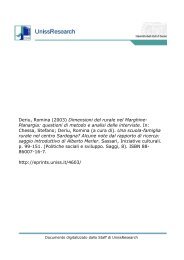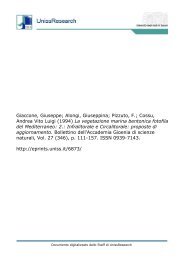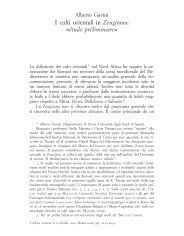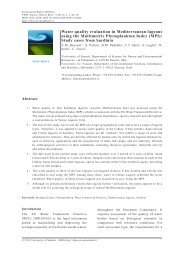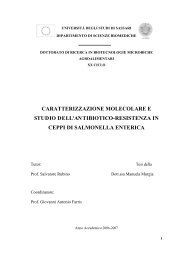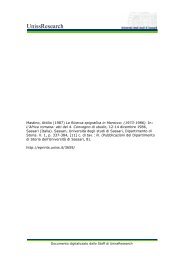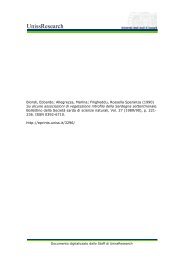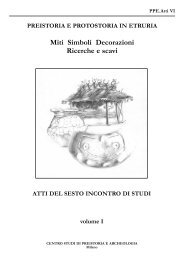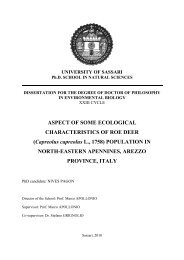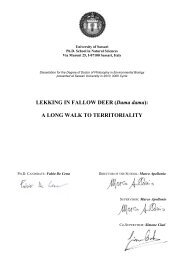- Page 1 and 2:
UnissResearch Mastino, Attilio a cu
- Page 3 and 4:
Pubblicazioni del Dipartimento di S
- Page 5 and 6:
Questo volume è stato stampato per
- Page 7 and 8:
6 Jean-Michel Roddaz au cours des p
- Page 9 and 10:
lO Giancarlo Susini scersi e unific
- Page 13 and 14:
16 Lidiano Bacchielli - Lidio Gaspe
- Page 15:
18 Calendario dei lavori Intervento
- Page 18 and 19:
24 Calendario dei lavori l'Assessor
- Page 20 and 21:
28 Elenco dei partecipanti Alberto
- Page 22 and 23:
32 Elenco dei partecipanti Donatell
- Page 24 and 25:
34 Attilio Mastino gionale Superior
- Page 26:
Saluto del prof. Giovanni Palmieri
- Page 29 and 30:
44 Mario Manca Spero quindi che la
- Page 31:
48 Giovanni Drizzi COSÌ, malgrado
- Page 34 and 35:
54 René Rebuffat que des expressio
- Page 36 and 37:
58 Eugenio Lanzillotta Cirenaica, a
- Page 38 and 39: Azedine Beschaouch L'Africa Romana,
- Page 40: M'hamed Fantar L'épigraphie puniqu
- Page 46 and 47: Tavola II
- Page 48 and 49: Tavola IV
- Page 50: Cinzia Rossignoli Persistenza del c
- Page 62 and 63: 96 Cinzia Rossignoli LÉZINE 1960:
- Page 64 and 65: vola II 1: Mozia, antuario del Capp
- Page 66: """i 2: Monte Sirai, «tempio del m
- Page 69 and 70: J esper Carlsen Dispensatores in Ro
- Page 73 and 74: 104 Jesper Carlsen themselves and s
- Page 76 and 77: 108 Arnaldo Marcone Il discorso si
- Page 80 and 81: Fadel Ali Mohamed - J oyce Reynolds
- Page 82 and 83: 118 Fadel Ali Mohamed - Joyce Reyno
- Page 84 and 85: New inscription no. 1. Photograph b
- Page 87: New inscription no. 4. Photograph b
- Page 100: 142 Mario Luni Va messo in evidenza
- Page 103 and 104: Tavola I a: Modellino relativo alla
- Page 105 and 106: Tavola III a: Trabeazione del propi
- Page 107 and 108: Tavola V Grosso blocco di architrav
- Page 109 and 110: Tavola VII a: Resti del crollo dell
- Page 111 and 112: Tavola IX a: Propileo orientale, fa
- Page 113 and 114: a: Prospetto interno del propileo o
- Page 119: 154 Claudio Parisi Presicce Le cara
- Page 125 and 126: Tavola II 1: Iscrizione con legge s
- Page 127: Tavola IV 1: Santuario di Apollo. A
- Page 130: Panakeia, Iatros e le a/tre divinit
- Page 133: Serena Ensoli Vittozzi Indagini sul
- Page 140:
180 Serena Ensoli Vittozzi dimensio
- Page 157:
214 Serena Ensoli Vittozzi Tornando
- Page 160:
220 Serena Enso/i Vittozzi Il tempi
- Page 167:
234 Serena Ensoli Vittozzi La testa
- Page 172 and 173:
244 Serena Ensoli Vittozzi La piant
- Page 174 and 175:
248 Serena Ensoli Vittozzi La conti
- Page 176 and 177:
2: Tocra, Santuario di Demetra. Sta
- Page 178 and 179:
Tavola III 1: Cirene, Santuario di
- Page 180 and 181:
Tavola V l: Cireneo Frammenti di st
- Page 182 and 183:
Tavola VII 1: Cirene, Acropoli, San
- Page 184 and 185:
Tavola IX 1: Cirene, Acropoli, Sant
- Page 186 and 187:
Tavola XI l: Cirene, Nomophylakeion
- Page 188:
Tavola XIII l: Cirene, Santuario di
- Page 191:
Tavola XVI Cirene, Santuario di Apo
- Page 194 and 195:
2: Cirene, Acropoli, Santuario di I
- Page 196 and 197:
l: Cirene, Acropoli, Santuario di I
- Page 198 and 199:
Tavola XXIII l: Cirene, Acropoli, S
- Page 200 and 201:
Tavola XXV 1: Cirene, Santuario di
- Page 202 and 203:
Ahmed M'charek Inscriptions découv
- Page 204:
254 Ahmed M'charek magne 22 en 1941
- Page 207 and 208:
Inscription de Henchir Ghayada. Ex-
- Page 209:
nscriptions découvertes entre Zama
- Page 213:
Andreina Magioncalda L'epigrafe da
- Page 220:
.278 Andreina Magioncalda di 250 se
- Page 227:
Zeineb Ben Abdallah - Habib Ben Has
- Page 232 and 233:
Tavola I
- Page 234 and 235:
Lieu de la découverte de la dédic
- Page 236:
La dédicace de Chidibbia au rnorne
- Page 241:
304 Samir Aounallah o Fig. 2 - Vill
- Page 245 and 246:
312 Samir Aounallah Une nouvelle in
- Page 248 and 249:
318 Samir Aounallah thage, ce qui c
- Page 250 and 251:
Mustapha Khanoussi Présence et rol
- Page 252 and 253:
322 Mustapha Khanoussi tie du Haut
- Page 254 and 255:
326 Mustapha Khanoussi sence milita
- Page 256 and 257:
Stèle du légionnaire L. Obulcius,
- Page 258:
: Stèle du légionnaire L. Vo/asen
- Page 261 and 262:
Fathi Bejaoui A propos des mosalque
- Page 263 and 264:
332 Fathi Bejaoui sur les bordures
- Page 265:
a ola I
- Page 268 and 269:
L'épitaphe de Tribunus pretre, «i
- Page 270 and 271:
L'épitaphe de Stefanus. a ola
- Page 272 and 273:
L épitaphe de Menas, «in itu». a
- Page 274 and 275:
a ola
- Page 276 and 277:
L'épitaphe de Basilius après dép
- Page 278 and 279:
Le deux épitaphe de l'ab ideo a la
- Page 280 and 281:
La dédicace d'Anastasia, «in itu
- Page 282 and 283:
Tavola XVIII
- Page 284 and 285:
336 Fathi Bejaoui qu'un exemple a
- Page 287:
340 Michel Christol que celui-ci to
- Page 290:
346 Jean-Paul Rey-Coquais I Cilicum
- Page 293 and 294:
Inscriotion de Bevrouth (AE 1926. 1
- Page 295:
Un légat d'Afrique 351 M. Sentius
- Page 298:
354 Francesca Ghedini a Bou Arkoub,
- Page 301 and 302:
J ohannes Irrnscher Inscriptiones A
- Page 303 and 304:
364 Johannes Irmscher hannes Arsaci
- Page 305 and 306:
366 Xavier Dupuis - Pierre Morizot
- Page 307 and 308:
Tavola II Vue aérienne du site de
- Page 309 and 310:
l: Caisson de Sex. Tutius Cornelian
- Page 311 and 312:
2: Caisson de Tiourga (Cl. J. Merme
- Page 313 and 314:
Tavola VIII l: Rue de la basilique
- Page 315 and 316:
l: Caisson de Liberalis (vue latér
- Page 317 and 318:
Vue aérienne du site de Mendour (A
- Page 319 and 320:
Tavola XIV 8 o '" (1) > :.a u $
- Page 322 and 323:
370 Xavier DlJpuis - Pierre Morizot
- Page 331 and 332:
J ean-Pierre Laporte Datation des s
- Page 337 and 338:
400 Jean-Pierre Laporte extreme bon
- Page 339:
404 Jean-Pierre Laporte siècles de
- Page 345 and 346:
416 Jean-Pierre Laporte Fig. 7: St
- Page 348 and 349:
422 Jean-Pierre Laporte d'un sceptr
- Page 350:
426 Nacéra Benseddik hauteur et Om
- Page 353 and 354:
432 Tripolit. Numidie Césarien. Na
- Page 355 and 356:
436 Nacéra Benseddik 7. C/L VIII 9
- Page 358:
440 René Rebuffat la prov{nce 9 ,
- Page 361:
446 René Rebuffat retenus par l'It
- Page 367:
458 René Rebuffat Récapitulation
- Page 371:
466 René Rebuffat - «Environ 2,5
- Page 376:
476 René Rebuffat Par rapport à l
- Page 381:
486 René Rebuffat Liste des diplom
- Page 387:
498 René Rebuffat peut-etre d'autr
- Page 392 and 393:
2: Volubilis, IAM 802. l: Volubili,
- Page 394:
1: Volubilis, IAM 523, rainure du c
- Page 397 and 398:
Michael Speidel The Cereus of Tamud
- Page 399 and 400:
Tamuda (MASTINO 1990, p. 257 fig. 3
- Page 401 and 402:
5 JEAN-MICHEL RODDAZ, Présentation
- Page 403 and 404:
512 Sommario 673 ANTONIO SANCIV, Bo



